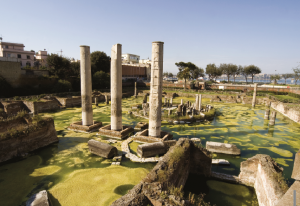This imposing archaeological site at Pozzuoli is not only a historical marker, but also lasting proof of the volcanic activities that have dogged the Naples area for centuries

Situated in the Campi Flegrei near Naples, the temple at Pozzuoli (in truth a market area where meat was sold) is a lasting testament to the regular seismic activity for which the area is renowned.
The technical term for the activity is bradyseism – the uplift or subsidence of land as a result of volcanic tremors and the filling or emptying of an underground magma chamber. Often, if the subsidence takes the landscape below ground level, water will flow in, as seen here at the Temple of Serapis.
Further evidence of land movements over the centuries can be seen on the three majestic marble columns at the site. Erosion from sea molluscs appears seven metres high on the pillars, showing how the land has sunk and risen in relation to sea level. The most recent activity in the area was between 1982 and 1984 when the land rose around two metres, and the earthquake of October 1983 left 30,000 homeless.
